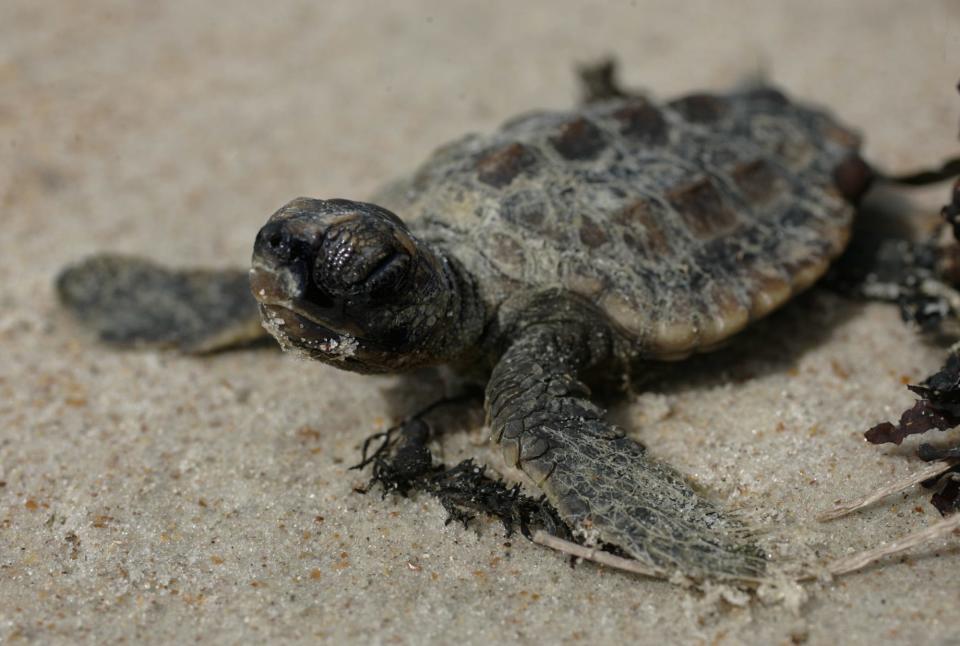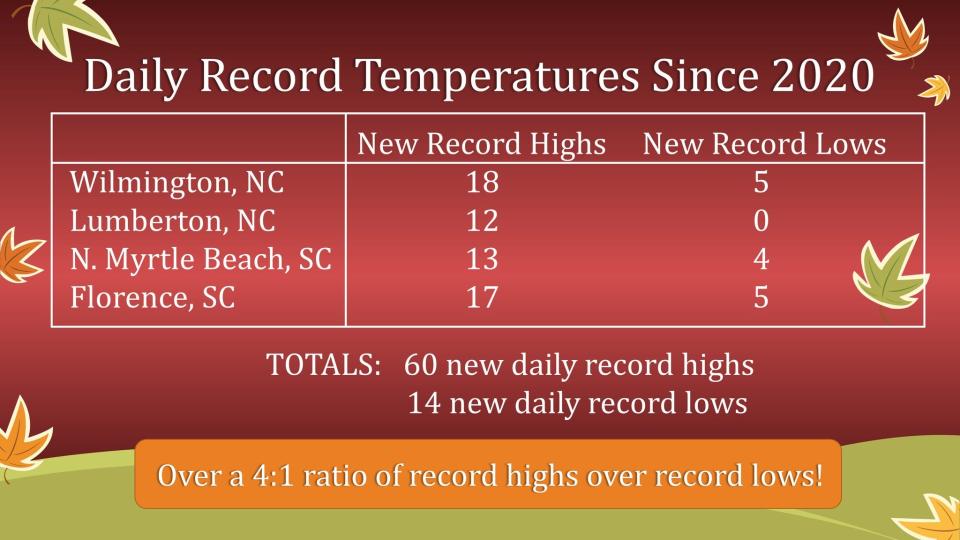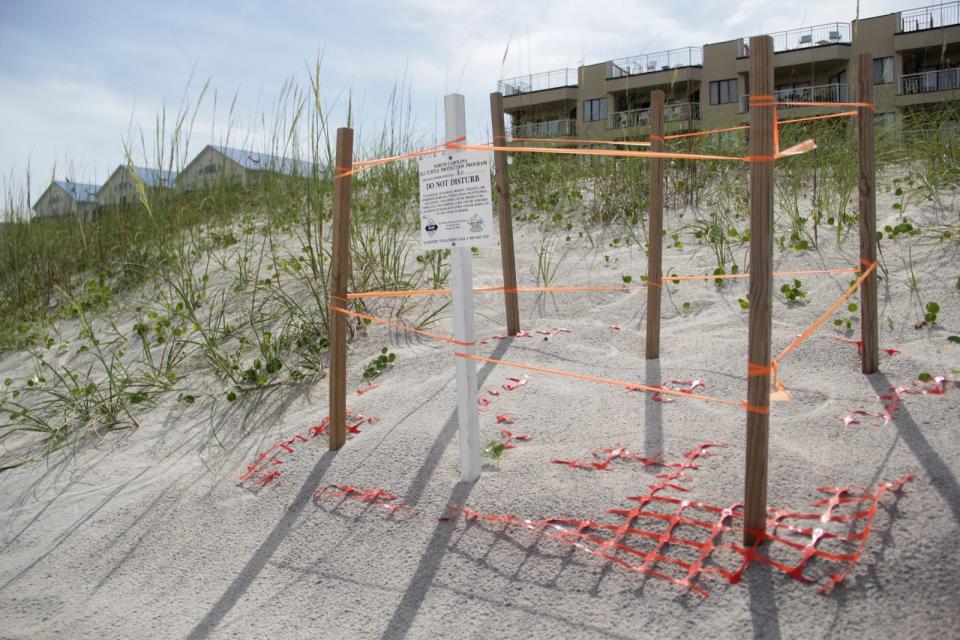NC sea turtle nests could be producing fewer males. Here's why that's a huge problem.
For the unofficial mascot of the North Carolina coast, things have been looking up in recent decades after a rough previous century or longer.
Thanks to continuing educational outreach campaigns, aggressive beach monitoring programs and ongoing fishing gear regulations, sea turtle numbers both on and off the beach have been creeping up. Although nesting statistics are notoriously volatile, the N.C. Wildlife Resources Commission recorded 1,497 turtle nests in 2021. That’s down from 2,358 in 2019, but up from 1,223 reported in 2017 and 618 In 2009.
But something else is also creeping up along the coast – temperatures. And when it comes to the sea turtle’s future, that’s a big deal.
“I think it’s going to be a major concern for our sea turtle populations moving forward because we’re just not making enough boys," said Dr. Stephanie Kamel, a marine biologist with the University of North Carolina Wilmington.
Related: Sea turtle nesting season is here. What you can do to protect these tiny creatures.
One turtle, two names: Rare two-headed baby sea turtle found alive on North Carolina beach
Heating up
Many reptile species have temperature-dependent sex determination. Research has found sea turtle embryos are particularly sensitive to small changes in sand temperature, with males developing at cooler temperatures and females developing at warmer temperatures.
In simple terms, a nest temperature of 29 Celsius (84.2 Fahrenheit) will produce an equal number of male and female hatchlings. A lower temperature would produce more males, while warmer temperatures would produce more females.

But impacts from warm sand temperatures goes beyond sex determination. At high incubation temperatures, hatchlings may develop smaller or with other disabilities or abnormalities.
The state’s 2020 Climate Risk Assessment and Resilience Plan stated that annual average temperatures in North Carolina have been consistently above normal since the 1990s, with the Tar Heel State enduring its warmest 10-year span between 2009 and 2018. Data indicates that 2019 was the state’s warmest on record. The state's warming trend was echoed by the National Oceanic and Atmospheric Administration’s (NOAA) 2022 state climate summary for North Carolina.
“Temperatures in North Carolina have risen more than 1 (degree Fahrenheit) since the beginning of the 20th century,” the report stated. “Under a higher emissions pathway, historically unprecedented warming is projected during this century.”

'Simply not enough males'
Dr. Jeanette Wyneken, a marine biologist at Florida Atlantic University in Boca Raton, has been studying sea turtle nest sex ratios in South Florida for decades.
She said as temperatures have been increasing since World War II, more female hatchlings have helped loggerhead and other sea turtle species recover from previous losses due to habitat loss, fishing hazards and harvesting of their eggs for food.
"Up to a point, that's fine," she said of having a female-heavy population. "But you get to a point that there's simply not enough males."
The northern subpopulation of loggerheads, which is listed as "threatened" by the federal government, makes up the vast majority of nesting sea turtles in North Carolina, South Carolina, Georgia and northeast Florida. With North Carolina the northern fringe of the turtle's nesting range, experts have surmised that Carolina nests — on beaches that are generally cooler than those farther south — could produce males to help compensate for fewer boys from more southern nests.
But what happens when even Tar Heel State beaches are significantly warmer than 29 Celsius and start producing higher ratios of female hatchlings?
“The two things scare me the most are when it’s too hot to hatch and when there aren't enough males," Wyneken said.
Checking the gender of turtle hatchlings, however, is neither easy nor cheap. Since hatchlings don't have obvious sex organs, testing requires either holding onto them in captivity for a few months until the organs start to develop or sacrificing some hatchlings to determine their gender.
Wyneken, who along with other researchers around the world is working on a simpler, cheaper and less obtrusive way of determining the sex of hatchlings, said there are ways — including shading and watering nests — to artificially lower nest temperatures to produce more males.
"But that’s a Band-Aid on the problem, because you would still be putting turtles out into a world that’s too hot to make boys," she said.
Previous coverage: On the Outer Banks, structures rise and fall as climate change looms
Stronger storms?: In a warming world, 'Cat 6' hurricanes could soon be coming to a coast near you
'Telling us a story'
On Topsail Island, it's looking like another pretty good year for nesting turtles. Terry Meyer, conservation director with the Karen Beasley Sea Turtle Rescue and Rehabilitation Center in Surf City, said the nest count is over 80 at roughly the midpoint of the summer nesting season. An average year is about 125 nests, with 103 recorded last year.
Meyer said they also haven't seen an increase in non-viable eggs or other issues with hatchlings. But she said the looming question of whether there are already or will be too few males to keep populations viable is a major worry.
"But will it be too late when we find out?" Meyer said. "For us visually as citizen-scientists, we would have no way of knowing if we're seeing fewer males."
Dr. Matthew Godfrey, sea turtle expert with the N.C. Wildlife Resources Commission, said so far researchers haven’t documented a decline in hatching success of sea turtle nests, which would be expected if there were too few males available to fertilize eggs.

"However, as you say, given the long time to maturity, if starting this year only female hatchlings are produced, we probably wouldn’t detect issues in breeding success for several decades," he said via email. Female sea turtles can take up to 30 years to reach sexual maturity and return to the general region of where they hatched.
Research by UNCW last decade found hatchlings from nests laid on Bald Head Island in Brunswick County were more likely to be female versus hatchlings produced from nests laid the previous two decades, and Wyneken said research from Australia is already showing some green sea turtle populations closer to the equator are producing nests that are nearly 100% female.
But sea turtles have survived for millions of years, and this isn't the first time they've been forced to adapt to a warming trend. Actions sea turtles could take to mitigate today's climbing temperatures is to lay their nests on beaches farther north, which should be cooler, or to nest earlier in the year. Nesting data for North Carolina shows that might already be happening to a degree, with the first nest recorded May 14 in 2009, May 8 in 2015, and May 4 this year.

But Godfrey cautioned that there is concern among researchers that human-driven climate change might be occurring faster than similar events in the past, and sea turtles will not be able to adapt quickly enough.
“The solution to this is not just a solution for sea turtles," Wyneken said. "When it's too hot for them, it's too hot for us. The turtles are trying to tell us a story, and we really should listen."
Reporter Gareth McGrath can be reached at GMcGrath@Gannett.com or @GarethMcGrathSN on Twitter. This story was produced with financial support from 1Earth Fund and the Prentice Foundation. The USA TODAY Network maintains full editorial control of the work.
This article originally appeared on Wilmington StarNews: Warming temperatures could mean fewer males in NC sea turtle nests

